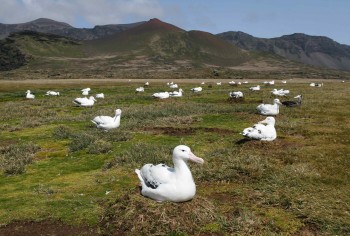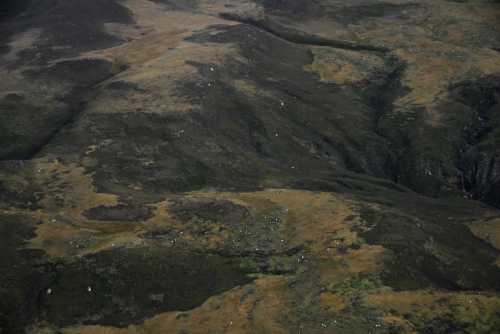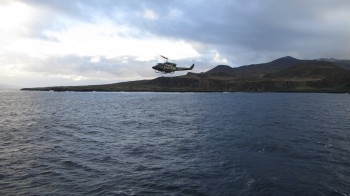On departing Marion Island around midday on 9 May, the S.A. Agulhas II sailed across the 19-km gap to the smaller and rarely-visited Prince Edward Island, where it launched one of its two Bell 212 helicopters offshore from Cave Bay in the afternoon. With marine ornithologists Bruce Dyer (Oceans & Coasts, Department of Environmental Affairs) and Ben Dilley (Percy FitzPatrick Institute of African Ornithology, University of Cape Town) aboard, a complete-island photographic survey of the ACAP-listed and Vulnerable Wandering Albatrosses Diomedea exulans was achieved, including of the densely-populated Albatross Valley and west-coast sections.

Wandering Albatrosses on Prince Edward’s west coast with the island’s escarpment behind
Photograph by Peter Ryan

Aerial photograph of Wandering Albatross chicks and adults in upper reaches of Albatross Valley
Photograph by Ben Dilley
By the end of the first week of May the brood/guard stage is all but over for Wanderers at the Prince Edward Islands so the count, once made from the photographs taken, will reveal how many chicks have survived to when they are left unattended by their parents in between feeds. Based on data being collected from three intensively-monitored colonies on Marion Island a rough estimate can be made of the number of breeding pairs that laid eggs in the current season on Prince Edward. This figure can then be added to the Marion whole-island ground count of incubating birds made earlier in the year to obtain a population estimate for the island group for 2013.

The helicopter returns to the ship from the vicinity of Cave Bay after a successful survey flight
Photograph by John Cooper
The annual relief of the weather/research station on Marion Island will end when South Africa’s new Antarctic research and supply vessel (with ACAP’s Information Officer aboard) docks in Cape Town on the 16th of this month.
With thanks to Ben Dilley and Bruce Dyer.
Selected References:
Ryan, P.G., Cooper, J., Dyer, B.M., Underhill, L.G., Crawford, R.J.M. & Bester, M.N. 2003. Counts of surface-nesting seabirds breeding at Prince Edward Island, summer 2001/02. African Journal of Marine Science 25: 441-451.
Ryan, P.G., Jones, M.G.W., Dyer, B.M., Upfold, L. & Crawford, R.J.M. 2009. Recent population estimates and trends in numbers of albatrosses and giant petrels breeding at the sub-Antarctic Prince Edward Islands. African Journal of Marine Science 31: 409-417.
John Cooper, ACAP Information Officer, 15 May 2013

 English
English  Français
Français  Español
Español